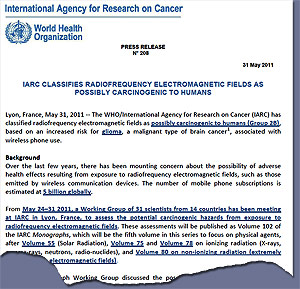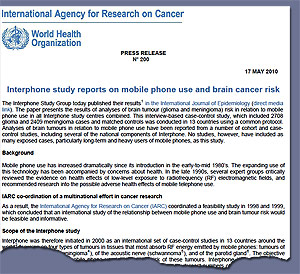 |
 |
|
WHO Classifies Radiofrequency Electromagnetic Fields As Possibly Carcinogenic To Humans
This has serious implications for the use of any equipment which uses radiofrequency electromagnetic fields, e.g. mobile phones, and for the exposure levels being sustained by workers and the general public. Once again, the health risks associated with mobile phone use cannot be dismissed as being non existent. Derek Maylor, Chair of the NW BTU H&S Co-ord has called for the monitoring of the use of BT trackers in vans, following the publication of the WHO's recommendation. The background to the decision by the WHO to classify radiofrequency electromagnetic fields as possibly carcinogenic to humans relates to the mounting concern over the last few years about the possibility of adverse health effects resulting from exposure to radiofrequency electromagnetic fields, such as those emitted by wireless communication devices. The number of mobile phone subscriptions is estimated at 5 billion globally. The IARC Monograph Working Group discussed the possibility that these exposures might induce long‐term health effects, in particular an increased risk for cancer. This has relevance for public health, particularly for users of mobile phones, as the number of users is large and growing, particularly among young adults and children. International experts shared the complex task of tackling the exposure data, the studies of cancer in humans, the studies of cancer in experimental animals, and the mechanistic and other relevant data. The evidence was reviewed critically, and overall evaluated as being limited2 among users of wireless telephones for glioma and acoustic neuroma, and inadequate3 to draw conclusions for other types of cancers. The evidence from the occupational and environmental exposures mentioned above was similarly judged inadequate. The Working Group did not quantitate the risk; however, one study of past cell phone use (up to the year 2004), showed a 40% increased risk for gliomas in the highest category of heavy users (reported average: 30 minutes per day over a 10‐year period).
The Interphone Study Group concluded their report with a key message: There were suggestions of an increased risk of glioma, and much less so meningioma, in the highest decile of cumulative call time, in subjects who reported usual phone use on the same side of the head as their tumour and, for glioma, for tumours in the temporal lobe. Biases and errors limit the strength of the conclusions that can be drawn from these analyses and prevent a causal interpretation. What next you may ask. Dr Christopher Wild, Director of IARC said: "An increased risk of brain cancer is not established from the data from Interphone. However, observations at the highest level of cumulative call time and the changing patterns of mobile phone use since the period studied by Interphone, particularly in young people, mean that further investigation of mobile phone use and brain cancer risk is merited." In an almost mirroring of the conclusions of the UK’s Stewart Report into mobile phone use and the risks to health, Professor Elisabeth Cardis said that "the Interphone study will continue with additional analyses of mobile phone use and tumours of the acoustic nerve and parotid gland." She added:,"Because of concerns about the rapid increase in mobile phone use in young people − who were not covered by Interphone −, CREAL is co-ordinating a new project, MobiKids, funded by the European Union, to investigate the risk of brain tumours from mobile phone use in childhood It appears then that studies done so far have been shrouded by arguments about interpretation of the results and the pressures of governments and big business on the study groups, particularly with the Interphone group. It is very interesting that the WHO has now decided that the best cause of action is to classify as radiofrequency electromagnetic fields as possibly carcinogenic to humans. You can download both documents illustrated above from the E-Library Database by choosing category of Electromagnetic Radiation from the category drop-down list. The Interphone Study Results can also be downloaded from the E-Library Database by using the keyword Interphone The full WHO/IARC report will appear in the Lancet website shortly. Source: WHO / IARC
|

